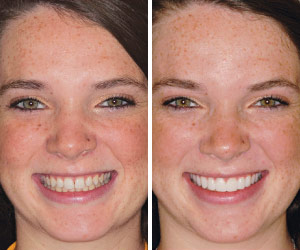Porcelain Veneers
Strength & Beauty As Never Before
(Continued)
Step 1: Imagining The Future
A smile makeover is a true collaboration — between your dentist, the dental laboratory technician and you. So the first step is to figure out what you feel needs to be changed about your smile. You should discuss not only the problems you would like to correct, but also the smile you would like to have. Sharing pictures of smiles you like in magazines or how your teeth looked when you were younger is extremely helpful.
Beauty is highly subjective, so your thoughts and standards are very important. For example, some people say they don't want anyone to know they've had work done — everything needs to look completely natural. Others want a bolder, super-white Hollywood smile. Your doctor wants to know what appeals to you personally. Of course, there are things a dentist might be able to point out to you, based on professional knowledge of the finer points of smile design.
For example, some people may have uneven gum heights between their two front teeth. When recognized beforehand, it's easy to even out the gum heights before the veneers are made to make the teeth match each other in every way. Since about 80 percent of people show gum above their front teeth, gum contours matter quite a bit. Yet very few patients would know they could benefit from this type of adjustment if it was not pointed out to them.
Step 2: The Trial Run
 |
| This young woman received an exciting preview of what permanent porcelain veneers could do for her smile when acrylic temporary veneers were applied to her teeth first. Click to enlarge |
There are several ways you can preview what porcelain veneers can do for your teeth before you fully commit to this treatment. For example, your dentist can create a life-size exact model of your teeth and then shape “veneers” onto the model using wax, to preview what can be achieved.
An even better way to explore the possibilities is for your dentist to make trial veneers out of an acrylic plastic or tooth-colored filling material, which can be placed directly on your teeth. That way you actually get to preview your new smile by seeing what you would look like with it. You can't leave the office with the acrylic on your teeth, but you can take pictures of this trial look to share with family and friends.
Step 3: Preparing the Teeth
When you are satisfied that your dentist understands what you are looking for and the two of you have agreed on a plan, your teeth will be prepared for the new veneers. Tooth preparation varies from polishing the teeth to removing tooth structure from the front, biting edges or sides of the teeth with a dental drill. In addition to the starting condition of the teeth, the amount removed is dependent on the desired result, and position of the teeth; overall the goal is to remove as little tooth structure as possible. As we map out a plan to achieve the desired result, it is important to be clear about this part of the process before it begins, as tooth reduction is not reversible.
Step 4: Laboratory Artisans

Once your teeth are prepared, an impression (mold) of them will be made. This will be sent to the dental laboratory, where the technicians will use it to create an exact replica of your teeth upon which the veneers will be made. During the time the veneers are being made, which may take several weeks, you will wear a set of provisional veneers, also made of acrylic. Unlike the trial veneers, these will be cemented onto your teeth and you will be able to go about your daily activities — chewing, speaking and of course, smiling! Once you have had time to adapt to the changes (often a week or two), your dentist will have you back to fine-tune the subtle details of the provisional veneers and make sure you are pleased with every detail of their shape and contours. You should be able to speak, chew and smile comfortably and confidently. This step is very important because the provisional veneers need to look and function to your liking in order to ensure that the final veneers will as well.
Once everyone is pleased with the outcome, photographs and an impression of the provisional veneers will also go to the lab, to serve as a three-dimensional picture of what the outside of the veneers should look like. The dentist will also instruct the lab, with the aid of photographs, about your tooth-color preferences.
Step 5: Cementing the Deal
When the veneers come back from the lab, they will be physically bonded to your teeth in a manner so secure, it would take a dental drill or a laser to remove them. First, both your teeth and the inside of the veneers will be “etched” with a mild acidic solution. This etching process will open up tiny pores in both surfaces. The dentist then applies translucent cement that forms microscopic tags that fit into these pores. It's a seamless “micromechanical” attachment that will essentially make the tooth and veneer one unit.


